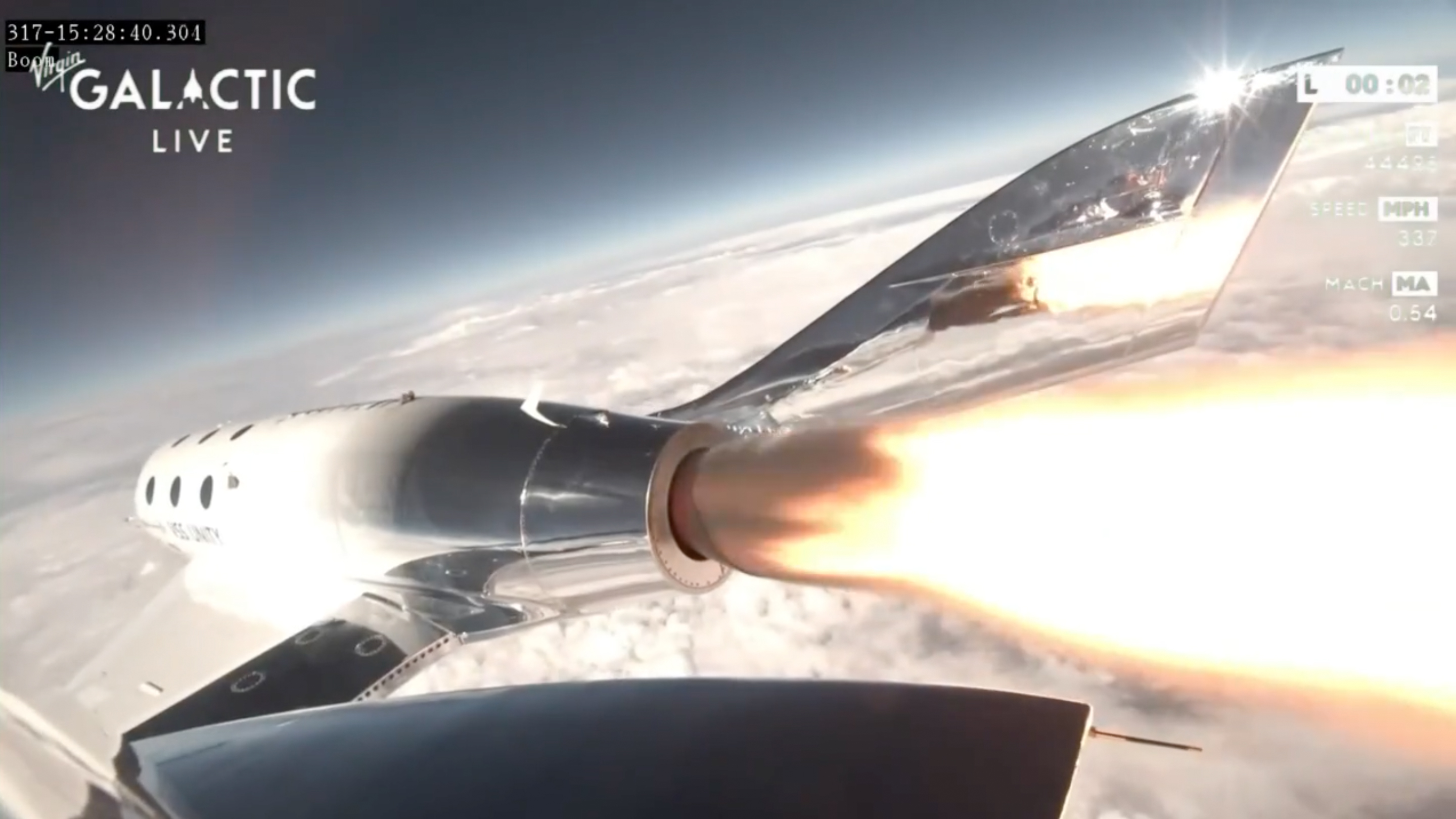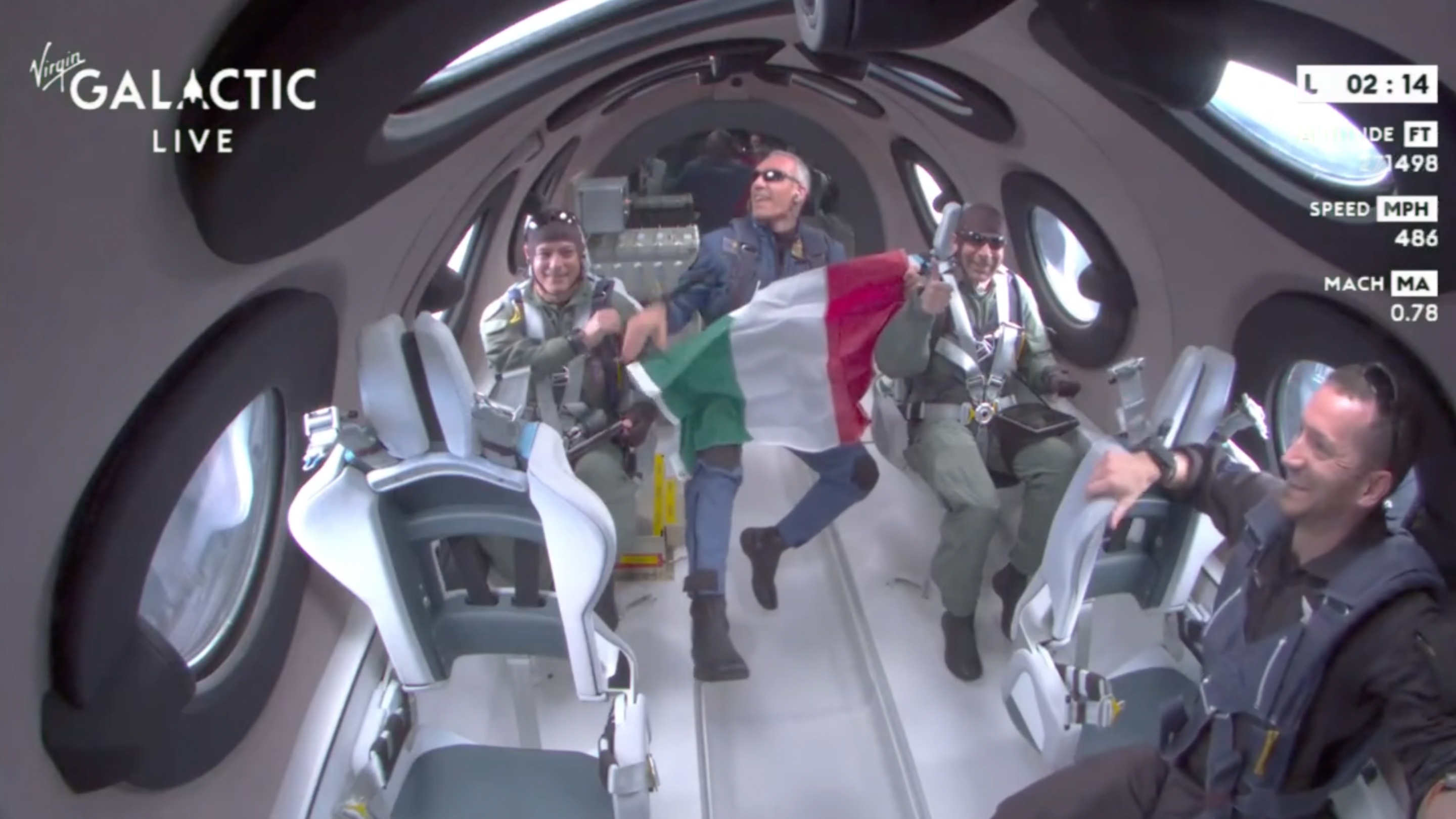Virgin Galactic aces its 1st-ever commercial launch of suborbital space plane (video)
Virgin Galactic is up and running.
The company aced its first-ever commercial mission today (June 29), sending four passengers to suborbital space and back. It was a landmark moment for Virgin Galactic, which has big ambitions in the final frontier.
The flight lifted off from Spaceport America in New Mexico at 10:30 a.m. ET (1430 GMT) and reached suborbital space some 58 minutes later. After a few minutes floating at an apogee of 52.9 miles (85.1 kilometers), the space plane then returned to Spaceport America and landed at 11:42 a.m. ET (1542 GMT).
"What a beautiful landing and a perfect way to complete our first commercial flight and our first dedicated science mission. Congratulations to everyone on board," Virgin Galactic's Sirisha Bandla said upon touchdown.
Related: What is Virgin Galactic and what do they do?
A long road to commercial flight
British entrepreneur Richard Branson founded Virgin Galactic in 2004. Back then, he predicted the company would be flying paying customers to and from the final frontier by 2007.
That optimism flowed from the performance of SpaceShipOne, which won the $10 million Ansari X Prize in October 2004 after reaching suborbital space twice in less than a week. Virgin Galactic based its suborbital space plane, known as SpaceShipTwo, on that groundbreaking private vehicle, which was hauled aloft by a carrier aircraft and dropped high in the sky. At that point, SpaceShipOne fired up its onboard rocket motor and made its own way to space.
Breaking space news, the latest updates on rocket launches, skywatching events and more!
SpaceShipTwo employs the same air-launch strategy, deploying from its carrier plane at an altitude of about 50,000 feet (15,000 m). Passengers aboard the spaceliner experience a few minutes of weightlessness and get to see Earth against the blackness of space before coming back down for a runway landing, which happens 70 to 90 minutes after takeoff.
But getting a spacecraft off the ground often takes longer than its developers think — especially when that vehicle is designed to carry people. Virgin Galactic didn't reach suborbital space until a December 2018 test flight of its latest SpaceShipTwo vehicle, the six-passenger, two-pilot VSS Unity.
Unity made the trip again on test flights in February 2019, May 2021 and July 2021 (a jaunt that included Branson among the passengers). Virgin Galactic then took Unity and its carrier plane, VMS Eve, out of action for nearly two years, performing maintenance and upgrade work designed to ready the duo for the increased cadence of commercial operations.
The revamped Eve and Unity took to the skies again on May 23 of this year, reaching suborbital space on a test flight for the fifth and final time. After that success, Virgin Galactic proclaimed the pair ready to carry its first customers and began prepping for today's mission, which the company called Galactic 01.
Related: Virgin Galactic's 1st fully crewed spaceflight with billionaire Richard Branson (photos)
An international mission
Galactic 01's customers were the Italian Air Force and the nation's National Research Council (known by its Italian acronym, CNR), which booked a SpaceShipTwo flight for suborbital research back in 2019.
The two organizations put three people on board Unity today: Walter Villadei, a colonel in the Italian Air Force; Lt. Col. Angelo Landolfi; and Pantaleone Carlucci, a strategic project coordinator for the CNR's stratospheric and air-launch platforms.
The trio carried a variety of scientific equipment on their flight today. For example, Villadei wore a biometric data suit, which tracked how his body responded to microgravity, and Carlucci sported a number of body sensors for a similar purpose.
Landolfi, a physician who has trained as a flight surgeon, conducted experiments about the mixing of certain solids and liquids in microgravity and characterized how the flight affected his cognitive state, among other work.
There was a fourth passenger in Unity's cabin today as well: Virgin Galactic astronaut instructor Colin Bennett, who assessed the Italian trio's flight experience to inform the company's efforts going forward. This was Bennett's second spaceflight; he was one of Branson's crewmates on the July 2021 test mission.
Mike Masucci and Nicola Pecile reached space today as well, as VSS Unity's commander and pilot, respectively. Kelly Latimer and Jameel Janjua flew VMS Eve, which remained firmly in Earth's atmosphere.
Picking up the pace
- Takeoff time: 10:30 a.m. EDT (1430 GMT)
- Altitude at VSS Unity release: 44,500 feet (13,564 meters)
- Maximum altitude reached: 52.9 miles (85.1 kilometers)
- Top speed: Mach 2.88
- Landing time: 11:42 a.m. EDT (1542 GMT)
Galactic 01 was just the beginning, if all goes according to plan for Virgin Galactic. The company says that hundreds of people have booked a ride aboard SpaceShipTwo, at a price (most recently) of $450,000 per seat.
Virgin Galactic aims to get these customers aloft as soon as safely possible. The second commercial flight, Galactic 02, is targeted for early August, and the company plans to fly Unity monthly from then on.
But the end goal is an even higher cadence, achieved with a fleet of space planes and carrier craft that Virgin Galactic is building out now. The new "Delta class" spacecraft will be capable of flying once per week, company representatives have said.
After the Delta vehicles come online, which is slated to begin happening in 2026, Virgin Galactic could potentially carry customers to space every day, from a variety of sites around the globe.
"That's going to be a big sea change when that occurs," Mike Moses, the company's president of spaceline missions and safety, told Space.com late last month. "I'm really looking forward to that from my commercial operations perspective. That's one of the reasons I joined this company, was to get to a place where space travel is a lot more routine for more folks."
Virgin Galactic isn't the only company trying to make this happen. Jeff Bezos' Blue Origin also flies customers to suborbital space, with a reusable rocket-capsule combo called New Shepard. Blue Origin has flown six crewed space missions to date, but the company hasn't left the ground since September 2022, when New Shepard suffered an anomaly during an uncrewed research flight.

Michael Wall is a Senior Space Writer with Space.com and joined the team in 2010. He primarily covers exoplanets, spaceflight and military space, but has been known to dabble in the space art beat. His book about the search for alien life, "Out There," was published on Nov. 13, 2018. Before becoming a science writer, Michael worked as a herpetologist and wildlife biologist. He has a Ph.D. in evolutionary biology from the University of Sydney, Australia, a bachelor's degree from the University of Arizona, and a graduate certificate in science writing from the University of California, Santa Cruz. To find out what his latest project is, you can follow Michael on Twitter.



